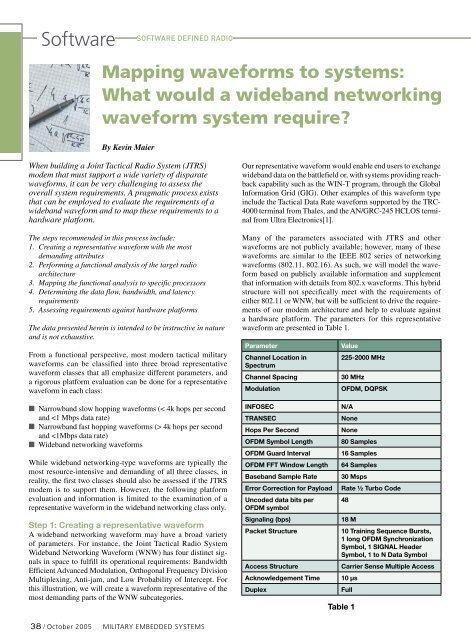Military Embedded Systems - Fall 2005 - Volume 1 Number 2
Military Embedded Systems - Fall 2005 - Volume 1 Number 2
Military Embedded Systems - Fall 2005 - Volume 1 Number 2
You also want an ePaper? Increase the reach of your titles
YUMPU automatically turns print PDFs into web optimized ePapers that Google loves.
Software<br />
Mapping waveforms to systems:<br />
What would a wideband networking<br />
waveform system require?<br />
By Kevin Maier<br />
Software Defined Radio<br />
When building a Joint Tactical Radio System (JTRS)<br />
modem that must support a wide variety of disparate<br />
waveforms, it can be very challenging to assess the<br />
overall system requirements. A pragmatic process exists<br />
that can be employed to evaluate the requirements of a<br />
wideband waveform and to map these requirements to a<br />
hardware platform.<br />
The steps recommended in this process include:<br />
1. Creating a representative waveform with the most<br />
demanding attributes<br />
2. Performing a functional analysis of the target radio<br />
architecture<br />
3. Mapping the functional analysis to specific processors<br />
4. Determining the data flow, bandwidth, and latency<br />
requirements<br />
5. Assessing requirements against hardware platforms<br />
The data presented herein is intended to be instructive in nature<br />
and is not exhaustive.<br />
From a functional perspective, most modern tactical military<br />
waveforms can be classified into three broad representative<br />
waveform classes that all emphasize different parameters, and<br />
a rigorous platform evaluation can be done for a representative<br />
waveform in each class:<br />
n<br />
n<br />
n<br />
Narrowband slow hopping waveforms (< 4k hops per second<br />
and 4k hops per second<br />
and
















